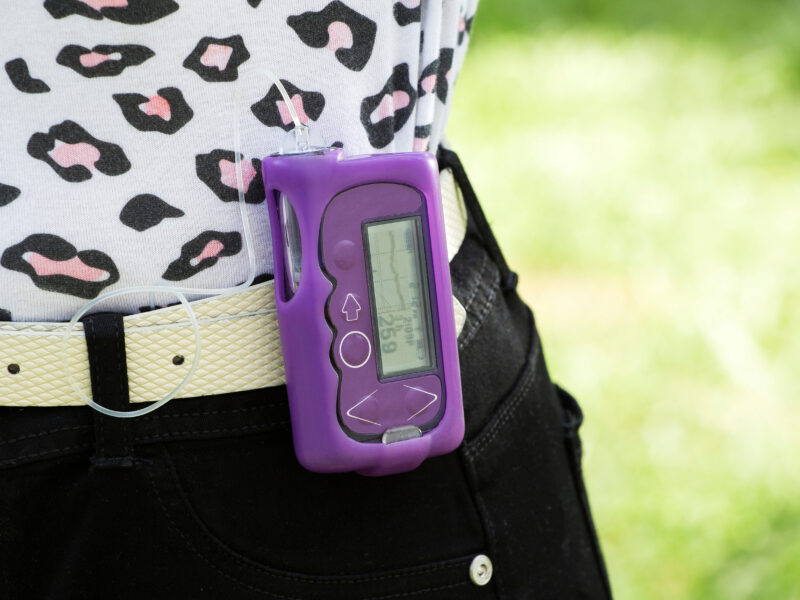How to Increase Continuous Glucose Monitoring Utilization in Patients With Type 1 Diabetes
How to Increase Continuous Glucose Monitoring Utilization in Patients With Type 1 Diabetes https://pediatricsnationwide.org/wp-content/uploads/2021/03/AdobeStock_104336092-1024x683.jpg 1024 683 Katie Brind'Amour, PhD, MS, CHES Katie Brind'Amour, PhD, MS, CHES https://pediatricsnationwide.org/wp-content/uploads/2021/03/Katie-B-portrait.gif- February 11, 2020
- Katie Brind'Amour, PhD, MS, CHES

An innovative quality improvement project grew the use of CGM nearly six-fold in 2 years.
A 2017 round-table meeting of the Type 1 Diabetes Exchange revealed that some diabetes clinics had a very small number of patients using continuous glucose monitors (CGM) — devices that allow patients to avoid repeated finger sticks to check glucose levels for their type 1 diabetes management — while other clinics had usage levels exceeding 40%. Nationwide Children’s Hospital attendees were surprised to discover that they had comparatively low numbers of patients on CGM (about 8%). Convinced the technology could improve the potential outcomes of their patients, they launched a quality improvement initiative that multiplied CGM use almost six-fold in just two years.
“We knew we could help our patients achieve better rates of usage,” says Kathryn Obrynba, MD, the endocrinologist at Nationwide Children’s who spearheaded the clinical planning and implementation of the quality improvement endeavor. “The first barrier to use is that someone needs to take the first step and knowledgeably navigate that process. We needed to help both our clinicians and our patients understand the benefits of CGM and the logistics of making it happen.”
While older CGM devices had accuracy concerns and required daily calibration with a finger stick test, recent versions of the devices have advanced and been shown to improve patient outcomes and quality of life. They reduce the burden of diabetes management and relieve the fear of hypoglycemia by alerting patients to rapid or dangerous changes in blood glucose levels.
Dr. Obrynba worked with Manmohan Kamboj, MD, chief of Endocrinology at Nationwide Children’s and the division’s quality improvement leader, and Don Buckingham, MBOE, CPHQ, lead service line quality improvement coordinator for the hospital. The team planned the project with other endocrinology clinicians, nurses, vendors, information technology staff and others to facilitate CGM uptake. The goal was to go from 8 to 20% patient CGM usage.
They identified key changes they thought could dramatically influence uptake, including clinician and patient education about CGM, identification of patients whose insurance covered CGM, auto-filled letters (via the electronic medical record system) requesting insurance coverage from other payors, and collaboration with the device vendor to help facilitate coverage efforts.
After about one year of gradual implementation of these efforts, the department achieved their target of 20% usage. Just a year later, the clinic had about 40% of their patients using CGM. Data from 2019 show the population is now at or above 50% usage.
“The trick was facilitating the entire process for everyone involved, and emphasizing the importance of this device to patients and families,” says Dr. Kamboj, who is now actively working with statewide advocacy groups and government health programs to expand CGM access for patients, since the team expects they will hit a ceiling for CGM usage due simply to limitations in insurance coverage. “If I had my way, everybody should get it at diagnosis. Why put children through finger pokes when you can monitor them even better this way?”
Their team has already begun applying lessons and products from this project to other initiatives.
“It took a lot of legwork and a collaborative information technology team to build and streamline a form for insurance providers that auto-populated with a patient’s details,” says Dr. Obrynba. “But now that the interface is in place, we’ve been able to adapt it for other uses as well — such as auto-filled letters requesting payor approval for insulin pumps.”
The importance of this form in enabling successful CGM initiation demonstrates the need for diverse, multidisciplinary involvement in a quality improvement initiative. Drs. Kamboj and Obrynba also stress the importance of commitment, both to working with insurance and vendors and to educating patients — some of whom are resistant to new technology if they’re comfortable with the traditional way of managing their diabetes.
“Once they have a CGM device, we find most patients and families are very reluctant to ever give it up and go back to multiple daily finger sticks,” says Dr. Obrynba. “Everyone agrees it gives them some sense of normalcy back in their lives.”
The Nationwide Children’s endocrinology team has been acknowledged by the Type 1 Diabetes Exchange for their rapid improvement and willingness to share their process in group meetings and ongoing advocacy efforts. They plan to present and publish their process and performance data in the near future.
Download the team’s practice tool to learn how the Nationwide Children’s Endocrinology team used quality improvement tactics to boost CGM use among their patients with type 1 diabetes — and succeeded in more than doubling their goal.
About the author
Katherine (Katie) Brind’Amour is a freelance medical and health science writer based in Pennsylvania. She has written about nearly every therapeutic area for patients, doctors and the general public. Dr. Brind’Amour specializes in health literacy and patient education. She completed her BS and MS degrees in Biology at Arizona State University and her PhD in Health Services Management and Policy at The Ohio State University. She is a Certified Health Education Specialist and is interested in health promotion via health programs and the communication of medical information.
-
Katie Brind'Amour, PhD, MS, CHEShttps://pediatricsnationwide.org/author/katie-brindamour-phd-ms-ches/April 27, 2014
-
Katie Brind'Amour, PhD, MS, CHEShttps://pediatricsnationwide.org/author/katie-brindamour-phd-ms-ches/April 27, 2014
-
Katie Brind'Amour, PhD, MS, CHEShttps://pediatricsnationwide.org/author/katie-brindamour-phd-ms-ches/April 27, 2014
-
Katie Brind'Amour, PhD, MS, CHEShttps://pediatricsnationwide.org/author/katie-brindamour-phd-ms-ches/April 28, 2014
- Post Tags:
- Endocrinology
- Posted In:
- In Brief







